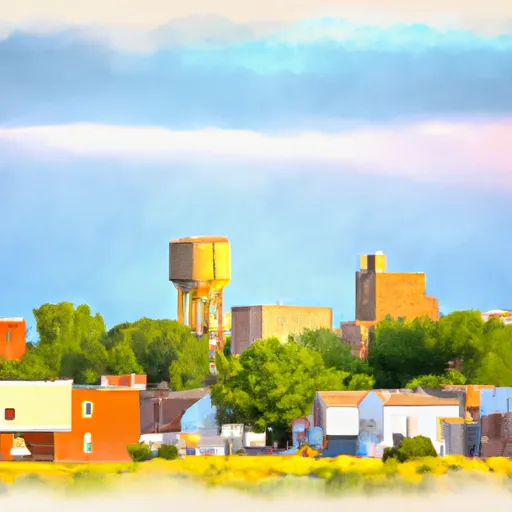-
 Snoflo Premium
Snoflo Premium
Get unlimited access to all our content
With no Ad interruptions! - Start Your Free Trial Login with existing account
Morse-Bluff
Eden Index
Climate
7.8
•
Recreation
0.6
•
Community
•
Safeguard
3.3/10

Morse Bluff is a small village located in Saunders County, Nebraska. The climate in Morse Bluff is characterized by hot summers and cold winters. Summers are typically warm with temperatures ranging from 80 to 90 degrees Fahrenheit, while winters can be quite cold with temperatures dropping to the 20s and 30s. Precipitation is evenly distributed throughout the year, with an average of 30 inches annually.
As for hydrology constituents, Morse Bluff is situated near Shell Creek, a tributary of the Platte River. This provides locals and visitors with opportunities for various outdoor water activities such as fishing, canoeing, and kayaking. Shell Creek also attracts wildlife, making it a popular spot for birdwatching and nature enthusiasts.
In addition to water activities, Morse Bluff offers several other outdoor recreation opportunities. The surrounding area is dotted with beautiful countryside, making it ideal for hiking, biking, and camping. The village also has a baseball field and a park where residents can enjoy picnicking and playing outdoor games.
Overall, Morse Bluff's climate, proximity to Shell Creek, and diverse outdoor recreational options make it an appealing destination for nature lovers and those seeking outdoor adventures in the heart of Nebraska.
What is the Eden Index?
The Snoflo Eden Index serves as a comprehensive rating system for regions, evaluating their desirability through a holistic assessment of climate health, outdoor recreation opportunities, and natural disaster risk, acknowledging the profound impact of these factors on livability and well-being.
Climate Health Indicator (CHI): 7.8
Morse-Bluff receives approximately
786mm of rain per year,
with humidity levels near 83%
and air temperatures averaging around
10°C.
Morse-Bluff has a plant hardyness factor of
5, meaning
plants and agriculture in this region thrive during a short period during spring and early summer. Most
plants will die off during the colder winter months.
By considering the ideal temperature range, reliable water supplies, clean air, and stable seasonal rain or snowpacks, the Climate Health Indicator (CHI) underscores the significance of a healthy climate as the foundation for quality living.
A healthy climate is paramount for ensuring a high quality of life and livability in a region, fostering both physical well-being and environmental harmony. This can be characterized by ideal temperatures, reliable access to water supplies, clean air, and consistent seasonal rain or snowpacks.
Weather Forecast
Streamflow Conditions
Lower Platte
Area Rivers
Lower Platte
Snowpack Depths
Lower Platte
Reservoir Storage Capacity
Lower Platte
Groundwater Levels
Recreational Opportunity Index (ROI): 0.6
The Recreational Opportunity Index (ROI) recognizes the value of outdoor recreational options, such as parks, hiking trails, camping sites, and fishing spots, while acknowledging that climate plays a pivotal role in ensuring the comfort and consistency of these experiences.
Access to outdoor recreational opportunities, encompassing activities such as parks, hiking, camping, and fishing, is crucial for overall well-being, and the climate plays a pivotal role in enabling and enhancing these experiences, ensuring that individuals can engage in nature-based activities comfortably and consistently.
Camping Areas
| Campground | Campsites | Reservations | Toilets | Showers | Elevation |
|---|---|---|---|---|---|
| Rockford Lake State Rec Area | 107 | 1,390 ft | |||
| Riverside Park - Beatrice | 10 | 1,249 ft | |||
| Blue Rapids/Riverside City Park | None | 1,121 ft | |||
| Diller City Park | 7 | 1,355 ft | |||
| Leisure Lake WMA | None | 1,358 ft | |||
| Big Indian NRD Rec Area | 50 | 1,334 ft | |||
| Marysville City Park | None | 1,144 ft | |||
| Waterville City | 6 | 1,161 ft | |||
| Chautauqua Municipal Park - Beatrice | 20 | 1,238 ft | |||
| Feits Memorial Park | 15 | 1,228 ft |
Nearby Ski Areas
Catastrophe Safeguard Index (CSI):
The Catastrophe Safeguard Index (CSI) recognizes that natural disaster risk, encompassing floods, fires, hurricanes, and tornadoes, can drastically affect safety and the overall appeal of an area.
The level of natural disaster risk in a region significantly affects safety and the overall livability, with climate change amplifying these risks by potentially increasing the frequency and intensity of events like floods, fires, hurricanes, and tornadoes, thereby posing substantial challenges to community resilience and well-being.
Community Resilience Indicator (CRI):
The Community Resilience Indicator (CRI) recognizes that education, healthcare, and socioeconomics are crucial to the well-being of a region. The CRI acknowledges the profound impact of these elements on residents' overall quality of life. By evaluating educational resources, healthcare accessibility, and economic inclusivity, the index captures the essential aspects that contribute to a thriving community, fostering resident satisfaction, equity, and social cohesion.

